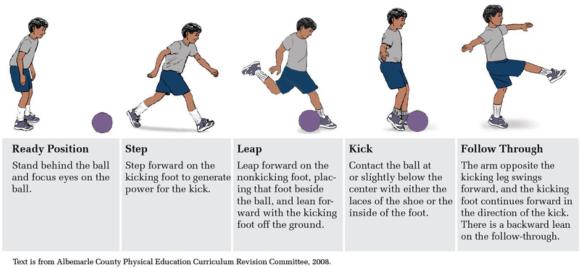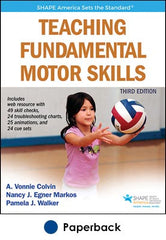Outcomes for kicking
This is an excerpt from Teaching Fundamental Motor Skills 3rd Edition With Web Resource by Allison Colvin,Nancy Markos & Pamela Walker.
Kicking
Children begin kicking by standing still and kicking a nonmoving object. The outcomes provide a logical skill progression. A kindergartener should be able to kick a stationary ball while standing still, demonstrating two of the five elements of a mature kicking pattern (S1.E21.K). The first grader should be able to kick a stationary ball after moving toward it, demonstrating two of the five elements of a mature kicking pattern (S1.E21.1). Finally, second graders advance to the last phase, in which they move toward and kick a moving ball, demonstrating three of the five elements of a mature kicking pattern (S1.E21.2). Once these tasks are accomplished, third graders should be able to kick a ball on the ground and in the air, demonstrating four of the five elements of a mature kicking pattern (S1.E21.3), and then they begin kicking for accuracy. (S1.E21.3). Unfortunately, educators sometimes attempt to teach this last skill (accuracy) before their students have mastered the earlier skills (technique). See table 9.1.

In this chapter, we emphasize the critical elements of kicking when the ball is stationary, and the child's movement is limited to his approach steps. We have included extensions for the child and the ball in motion where appropriate.
To increase practice time and promote safety, we recommend using one of the following suggestions for each activity:
- Use partially deflated balls so that students do not spend a lot of time chasing the balls they kick.
- Have students work with partners, but be sure they are a safe distance apart in case one child kicks a ball with excessive force.
- Use a wall or fence as the partner.
Of course, physical education catalogs today are filled with softer balls that are safer for kicking. Other options include inexpensive plastic balls and foam balls found in discount stores. Your equipment budget and facilities will dictate what precautions you use.
Critical Elements

Cue Words
The cue words you select for each phase of the skill will depend on the age of the students you are teaching and your areas of emphasis. In usable sets are some of the cue words that we use to teach kicking. You may use each set individually or mix and match the cue words as needed. We have found that it is beneficial to have the students say the cue words out loud as they practice.
- Ready - focus eyes on the stationary ball.
- Step - step forward with the kicking foot.
- Approach - watch the ball and step forward with the kicking foot.
- Leap - leap onto the nonkicking foot.
- Plant - plant the nonkicking foot beside the ball while bringing the kicking leg forward.
- And - step forward with nonkicking foot and place it beside the ball.
- Leg back - bring the kicking leg back.
- Kick - contact the ball below its center with either the inside of the foot (for balls that will stay on the ground) or shoe laces (for balls that will go into the air).
- Boom - swing the kicking leg forward and contact the ball below the center with either the shoelaces (for balls that will go into the air) or the inside of the foot (for balls that will stay on the ground.
- Follow through or high - kicking foot continues in the direction of the kick with the opposing arm stretched forward for balance.
- Cue set 1: ready, step, leap, kick, follow through
- Cue set 2: approach, leap, plant, kick, follow through
- Cue set 3: ready, leap, kick, high
- Cue set 4: ready, and, kick
- Cue set 5: leg back, boom
Learn more about Teaching Fundamental Motor Skills, Third Edition.
More Excerpts From Teaching Fundamental Motor Skills 3rd Edition With Web Resource

Get the latest insights with regular newsletters, plus periodic product information and special insider offers.
JOIN NOW
Latest Posts
- Outdoor recreation and adventure activities lead to positive health outcomes for children
- Schools offer a wide variety of adventure programs for children
- Using sport to change society
- Despite progress, equity remains a pressing challenge for women in sport
- What today’s athletes expect from coaches
- Barriers to youth participation in physical activity and sport


